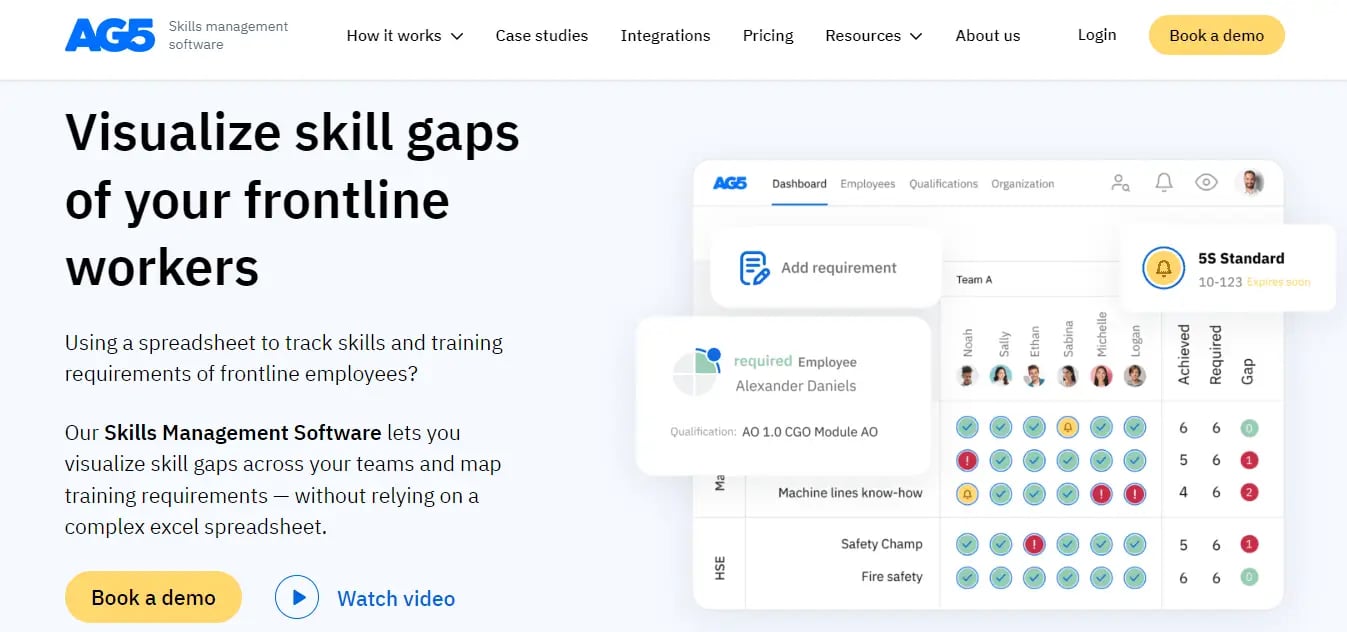Skills mapping tools are software platforms designed to help organizations identify, analyze, and organize employee skills in direct alignment with business needs. They provide a structured way to assess current workforce capabilities, uncover gaps, and plan for future talent development. This ensures the right people are in the right roles.
Unlike traditional HR systems, skills mapping software offers real-time insights that support smarter decisions around hiring, internal mobility, succession planning, and upskilling. According to the Willis Towers Watson 2025 Skills Survey, organizations that adopt a skills-based approach are 1.7× more likely to deliver better financial performance and 2× more likely to report higher employee productivity.
As technologies and job roles evolve faster than ever, the ability to map and manage workforce skills has become indispensable for aligning talent strategy with long-term business growth.
Key Features to Look for in a Skills Mapping Tool
To choose the right platform, prioritize tools that offer the following core capabilities:
- Skills Assessment: Measure employees’ technical, functional, and soft skills using validated assessments or self-evaluations to establish an accurate baseline.
- Skills Inventory: Maintain a centralized, real-time database of employee skills across the organization to support visibility and planning.
- Skills Gap Analysis: Identify mismatches between current capabilities and business requirements to guide upskilling and reskilling initiatives.
- Skill Matrix: Use structured, visual tools to compare skill levels across individuals and teams for better talent allocation.
- Workforce Planning: Align skills data with strategic goals to forecast talent needs and build resilient, future-ready teams.
In this blog, we explore 12 of the most effective skills mapping tools to consider for building a skills-first workforce in 2025.
|
Table of contents |
Top 12 Skills Mapping Tools to Consider in 2025
1. iMocha

iMocha is an AI-powered skills intelligence platform built for hiring, workforce development, and internal mobility. It offers a comprehensive skills taxonomy, job-role-specific ontologies, and benchmarking tools to evaluate talent against internal and industry standards. It also offers features for career pathing and succession planning by tracking skill readiness and progression. With built-in skills analytics, it offers clear visibility into skill gaps and enables smarter, data-driven talent decisions.
Features:
- Skills Taxonomy & Ontologies: Offers a structured, AI-powered taxonomy with role-specific ontologies that map primary, secondary, and adjacent skills across 3,000+ job roles.
- Skills Benchmarking: Enables organizations to evaluate internal talent against industry standards and high-performing peers.
- Career Pathing & Succession Planning: Supports internal mobility by tracking skill growth and role readiness, enabling data-driven career paths and succession planning.
- Skills Analytics Dashboard: Provides real-time insights into skills gaps, proficiency levels, and training effectiveness at individual and organizational levels.
- Job Architecture Integration: Aligns skills mapping with job frameworks, ensuring consistency in role definitions, expectations, and evaluations.
G2 Rating: 4.4/5 (276 reviews)
Founding Year: 2015
Pricing: Check out iMocha's pricing here
|
Manually gathering skills data, competencies, and proficiency scores is passé, get intelligent skills insights with iMocha's AI-enabled skills intelligence cloud. |
2. eloomi
 eloomi’s skills mapping software supports individuals and organizations in reaching their full potential across a variety of industries including technology, healthcare, finance, and education. The platform offers a comprehensive suite of courses that improve employee skills, enhance productivity, and foster a culture of continuous learning and innovation.
eloomi’s skills mapping software supports individuals and organizations in reaching their full potential across a variety of industries including technology, healthcare, finance, and education. The platform offers a comprehensive suite of courses that improve employee skills, enhance productivity, and foster a culture of continuous learning and innovation.
Features:
- Customized Learning Journey: eloomi offers an adaptive learning platform that customizes content to meet the individual needs and objectives of each learner.
- Extensive Course Selection: Access a broad selection of courses, including industry-specific certifications, soft skills development, and language learning.
- Flexible Learning Modalities: Engage in learning at your preferred pace and format, with choices ranging from online and blended to in-person sessions.
- Mobile Application: Utilize the convenience of eloomi’s mobile app to access courses from any location, enhancing flexibility and ease of use.
G2 Rating: 4.7/5 (35 reviews)
Founding Year: 2015
Pricing: eloomi has 3 pricing editions. A free trial of eloomi is also available.
3. TalentGuard
 TalentGuard is a worldwide provider of competency-based talent management solutions offered as Software-as-a-Service. Their cloud-based suite of software excels in engaging and retaining employees with its comprehensive features. This integrated technology enables organizations to automate various aspects of talent management including performance management, 360-degree feedback, career pathing, succession planning, individual development planning, and certification tracking.
TalentGuard is a worldwide provider of competency-based talent management solutions offered as Software-as-a-Service. Their cloud-based suite of software excels in engaging and retaining employees with its comprehensive features. This integrated technology enables organizations to automate various aspects of talent management including performance management, 360-degree feedback, career pathing, succession planning, individual development planning, and certification tracking.
Features:
- Performance Management
- Career Management
- Skills Management
- Succession Planning
G2 Rating: 4.7/5 (3 reviews)
Founding Year: 2009
Pricing: NA
4. Napta
 Napta is a customizable and user-friendly solution that seamlessly integrates with your existing IT infrastructure. It is a collaborative skills mapping software that enhances transparency in project and resource management for staff. Using Napta, employees have the opportunity to indicate their interest in upcoming projects and identify specific skills they wish to develop in the coming weeks through the software.
Napta is a customizable and user-friendly solution that seamlessly integrates with your existing IT infrastructure. It is a collaborative skills mapping software that enhances transparency in project and resource management for staff. Using Napta, employees have the opportunity to indicate their interest in upcoming projects and identify specific skills they wish to develop in the coming weeks through the software.
Features:
- Manage staffing requests
- Identify the most relevant staff for each project in real time
- Optimize the projects planning
- Map all your employees' skills and aspirations
- Conduct 360° feedback with your teams
G2 Rating: 4.3/5 (2 reviews)
Founding Year: 2017
Pricing: NA
5. Skills Base
 Skills Base's skills mapping software is designed from scratch with robust REST APIs. This tool allows you to construct an optimal technology stack using its skill and competency mapping software, enhancing the employee experience and delivering value to your customers. It is also straightforward to use and flexible for implementation.
Skills Base's skills mapping software is designed from scratch with robust REST APIs. This tool allows you to construct an optimal technology stack using its skill and competency mapping software, enhancing the employee experience and delivering value to your customers. It is also straightforward to use and flexible for implementation.
Features:
- Gain insights into skills and competencies with a tailored data model.
- Address and bridge skill gaps through targeted training and LMS integration.
- Enhance employee experiences by integrating with your HR platform.
- Map and visualize skill gaps and strengths using a competency mapping matrix.
G2 Rating: 4.6/5 (26 reviews)
Founding Year: 2012
Pricing: Skills Base has 4 pricing editions. A free trial of Skills Base is also available.
|
Want to measure the extent of the skills gap among employees? Try iMocha's Skills Intelligence Cloud platform. |
6. AG5
AG5's Skills Management Software allows you to identify skill gaps within your teams and outline training needs without the need for complicated Excel spreadsheets. It consolidates skills data and training requirements into a constantly updated training matrix. This eliminates the need for manually color-coding skills across multiple tabs to plan job execution.
Features:
- Effortlessly pinpoint skill gaps in your roles
- Maintain a Skills Matrix to keep your skills and job data current
- Guarantee the accuracy of your skills information
- Grant specific access permissions to individual employees, teams, or departments to control what they can view or edit
G2 Rating: 4.7/5 (16 reviews)
Founding Year: 2019
Pricing: AG5 has 4 pricing editions. A free trial of AG5 Skills Management Software is also available.
7. muchskills
 MuchSkills is a visualization tool for skills and strengths that enables individuals and teams to explore their abilities from a fresh perspective. This tool enhances productivity, engagement, and job satisfaction by aligning the right individuals with the right projects. Central to MuchSkills is the conviction that everyone seeks to work in areas they are passionate about. MuchSkills provides a platform for people to display their passions and strengths to the world.
MuchSkills is a visualization tool for skills and strengths that enables individuals and teams to explore their abilities from a fresh perspective. This tool enhances productivity, engagement, and job satisfaction by aligning the right individuals with the right projects. Central to MuchSkills is the conviction that everyone seeks to work in areas they are passionate about. MuchSkills provides a platform for people to display their passions and strengths to the world.
Features:
- Identify key productivity and cultural skills within the organization
- Specify the skills needed for organization-specific roles
- Explore software-specific features and functions
- Gather data and utilize intelligent competency mapping
G2 Rating: 4.5/5 (1 reviews)
Founding Year: 2019
Pricing: NA
| Discover top 11 skills matrix software that integrates seamlessly with skills mapping tools to identify and address skill gaps within your organization. |
8.Cognology
Cognology includes a variety of reports designed to provide insight into your organization's skills landscape. Among these, the Skills Matrix is particularly valuable as it aligns individuals with specific skills and employs color coding to easily highlight areas of proficiency and skill shortages.
Features:
- Documenting your workforce's skills
- Detecting skill deficiencies
- Continuous skills management
- Automated workflows
- Skill enhancement
G2 Rating: NA
Founding Year: 1994
Pricing: NA
9. HRSG
 HRSG’s Talent Management solution offers best practice professional services in competency-based management, testing, and assessment. Additionally, it provides training to HR professionals globally in its competency-based management methodologies.
HRSG’s Talent Management solution offers best practice professional services in competency-based management, testing, and assessment. Additionally, it provides training to HR professionals globally in its competency-based management methodologies.
Features:
- Explore a diverse range of behavioral and technical competencies refined over 30 years of experience.
- Empower your competency initiatives with purpose-built tools designed for rapid implementation.
- Involve employees in the selection of competencies relevant to both the organization and specific roles.
- Access an extensive bank of high-quality job descriptions, competencies, and interview questions to kickstart your programs.
- Customize resources to align perfectly with your unique needs and goals.
G2 Rating: NA
Founding Year: 1989
Pricing: NA
10. Augmentir
 Augmentir offers a comprehensive set of AI-driven connected worker solutions tailored to industrial firms, facilitating efficient skills management, training, digital workflows, and collaboration for the ever-evolving industrial workforce.
Augmentir offers a comprehensive set of AI-driven connected worker solutions tailored to industrial firms, facilitating efficient skills management, training, digital workflows, and collaboration for the ever-evolving industrial workforce.
These functionalities, leveraging Augmentir's patented "Smart" AI framework, bridge the gap between training and task execution, providing real-time data and insights essential for ongoing enhancements in operational excellence, ensuring continuous improvement day by day and year after year.
Features:
- Establish continuous visibility to enhance your training initiatives, monitor both individual and team advancements, and launch more precise training and upskilling endeavors.
- Digitize and streamline the management of your skills tracking and training schemes, seamlessly integrating them with your frontline operations.
- Visualize and monitor the skill sets of your workforce, swiftly evaluating readiness at both team and individual levels.
- Intelligently delegate tasks, ensuring optimal utilization of skills across your organization.
G2 Rating: 4.3/5 (20 reviews)
Founding Year: 2017
Pricing: NA
|
Are you struggling to identify the skills you need to stay ahead of your competition? Try iMocha! |
11. 365Talents
 365Talents offers a skills-based talent experience solution employing cutting-edge AI to streamline talent management processes globally. Companies can seamlessly manage skills data, frameworks, job descriptions, profiles, and matching across 45+ languages. The AI engages global employees through proprietary algorithms, presenting opportunities for internal mobility, learning, development, projects, mentorship, and beyond.
365Talents offers a skills-based talent experience solution employing cutting-edge AI to streamline talent management processes globally. Companies can seamlessly manage skills data, frameworks, job descriptions, profiles, and matching across 45+ languages. The AI engages global employees through proprietary algorithms, presenting opportunities for internal mobility, learning, development, projects, mentorship, and beyond.
Features:
- Analyze skills and strategize workforce planning
- Foster diversity by breaking silos
- Discover new career trajectories and unleash talent potential
- Equip your workforce with upskilling and reskilling opportunities
- Forge a resilient workforce for the future
G2 Rating: 4.8/5 (65 reviews)
Founding Year: 2015
Pricing: 365Talents has 4 pricing editions.
12. Neobrain
 Neobrain, an AI-driven digital platform, aids large and medium-sized companies (with over 5,000 employees) in effectively allocating skills where and when needed. With a comprehensive skills ontology comprising 70,000 skills and 26,000 jobs, Neobrain seamlessly integrates with various HR technologies such as Workday, SAP SuccessFactors, and Oracle via smart APIs.
Neobrain, an AI-driven digital platform, aids large and medium-sized companies (with over 5,000 employees) in effectively allocating skills where and when needed. With a comprehensive skills ontology comprising 70,000 skills and 26,000 jobs, Neobrain seamlessly integrates with various HR technologies such as Workday, SAP SuccessFactors, and Oracle via smart APIs.
Features:
- AI Skills Management: Enables dynamic mapping of company skills for optimized resource utilization.
- Internal Talent Marketplace: Enhances talent value by matching skills and motivations with new opportunities.
- Strategic Workforce Planning: Optimizes human resource allocation and analyzes gaps for future company needs.
- Performance & Engagement: Facilitates continuous performance optimization and monitors employee satisfaction and commitment accurately.
G2 Rating: 4.7/5 (56 reviews)
Founding Year: 2018
Pricing: Neobrain has 4 pricing editions.
| Explore the top 12 skills tracking software to keep your skills maps current, accurate, and aligned with workforce development goals. |
Conclusion
As the demand for a skilled, adaptable workforce continues to grow, skills mapping tools are becoming essential to organizational success. These platforms support informed decision-making by providing visibility into existing capabilities, future skill requirements, and areas that need development. Among the top tools, iMocha stands out for its structured skills taxonomy, skills analytics, and workforce planning features.
For organizations aiming to strengthen hiring, internal mobility, or long-term talent development, investing in the right skills mapping solution accelerates the transition to a skills-first strategy and enhances workforce readiness for the future.
| Check out the best training matrix software to connect mapped skills with structured training plans. |
|
Get ready to elevate your hiring and workforce management with iMocha's AI-powered Skills Intelligence Platform! |
FAQs
What is skills mapping?
Skills mapping is the process of identifying, documenting, and analyzing the skills of employees within an organization. It helps HR teams align workforce capabilities with business goals, identify gaps, and plan targeted learning or recruitment initiatives.
How do you create a skills map?
Creating a skills map involves defining role-specific skill requirements, collecting employee skill data (via assessments, self-reviews, or manager input), and organizing this information into a structured format like a skills matrix. This visualizes current strengths and highlights areas for development.
What is the difference between skill mapping and competency mapping?
Skill mapping focuses on specific, measurable abilities such as programming or communication. Competency mapping includes a broader mix of skills, behaviors, and attributes like problem-solving or leadership. While skill mapping is tactical, competency mapping supports strategic workforce planning and development.
|
|

